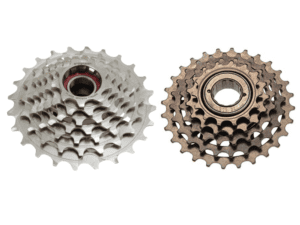While it all comes down to a biker’s own preferences, we think that “A full-face MTN helmet offers more protection to the face and head area. On the other hand, an open face helmet offers more comfort and relaxation to the biker.”
Let us explain the crucks and nitty-gritty details about these two bike helmet types so you can make a more informed buying decision,
Settling the Debate of Full Face vs Open Face Mountain Bike Helmets
Before we actually get into discussing each type of helmet with its pros and cons, you need to ask yourself some mandatory questions.
For instance,
- What kind of cycling do you do?
- Do you ride flat and smooth roads more often?
- Do you want to take on harsh challenges on rough trails?
- Are you just a casual commuter using a road bike more often?
- Do you want to become a hardcore mountain biker?
Answer these questions and if you think that you are more of a casual rider, then there’s no need to get a full-face helmet.
On the contrary, if you want to become a professional mountain biker, you may consider a full-face helmet that could offer proper protection and safety to your helmet.
Anyways, that’s not the end of the story!
Have a look at how full-face and open-face helmets differ from each other in different aspects.
Full Face Mountain Bike Helmets
A full-face mountain bike helmet is actually just like an open-face helmet but with a little addition of a chin guard and a full-face visor.
Such type of helmet offers more protection to the face, skull, and head of the biker. It’s thus a more suitable option when riders want to take on bumpy downhill trails more often.
That said, a full-face helmet offers better protection against serious crashes, but it does not mean you will get used to it anytime soon.
Due to the increased height and inclusion of a chin guard, riders won’t feel too comfortable while wearing it.
However, as they say, “You get used to something if you make a habit of it”, same is the case with a full-face helmet. It will keep you frustrated for a while, but you will get used to it eventually.
Regardless of whether the helmet feels comfortable or not, the question that whether it can protect your head, skull, face, and chin from serious injuries should be answered.
That is, YOU can ABSOLUTELY trust a full-face MTB helmet to protect you from serious injuries. With the kind of protection technologies it offers, you can take on harsh and rough downhill riding without facing any problems.
If we sum up the conversation about a full-face helmet, it’s worth getting it, especially when you are a hardcore cyclist. However, getting used to it and feeling comfy while wearing it will take sufficient time.
Pros of Full Face Bike Helmets
One of the biggest advantages of having a full-face helmet is that it can PROTECT your head region ENTIRELY!
Such helmets are designed in a way that no matter how hard the crash gets, a biker will survive it without sustaining serious injuries.
Not only that but having a full visor with a chin guard means complete mouth protection. Bikers will also get rid of dust, flies, and other foreign debris entering their mouth and causing any problems while wearing full-face helmets.
All in all, you will get the following benefits of wearing a full-face helmet;
- Complete head, skull, mouth, and chin protection.
- A full Face visor keeps the dust and flies away from entering the eyes or mouth.
- Offer enhanced security compared to an open-face helmet.
Most of the helmets designed for winters are also full-face helmets as the visor keeps the face protected from the cold air.
Cons of Full Face Helmets
Just like the advantages, MTN bikers also have to deal with some drawbacks of wearing these helmets.
For instance, a full-face helmet with its heightened structure will put more burden on your head and you’ll start feeling uncomfortable.
Similarly, such helmets offer reduced ventilation thus causing more sweat and suffocation to the rider.
More than all, many mountain bikers think that they’ve become invincible after wearing full-face helmets, but that’s a completely wrong perception. Although we agree that such helmets can reduce the risk of injuries, you must always remain careful enough while biking on harsh trails and try to control your bike at all costs.
Apart from the above-mentioned cons, full-face helmets are a bit expensive when we compare them with their open-face counterparts.
All in all, these helmets can;
- Cause discomfort, burden, and extra weight on the head.
- They are expensive.
- These helmets may not save you in an extremely harsh crash.
- Bikers feel overconfident while wearing such helmets, which is not a good practice.
- Wearing a full-face helmet does not mean you have got a high cycling skill level instantly.
Now, that we have discussed the details of full-face helmets already, it’s time to talk about the other type, i.e. an open-faced helmet.
Take a look:
Open-Face Mountain Bike Helmets
As the name suggests, an open-face bike helmet lacks a chin guard and more often a visor too. The helmet is light in weight and it covers the head and skull region only.
You may think that why do even bikers consider getting an open-face helmet if it does not offer maximum protection?
Well, there’s something called “COMFORT” and a sense of RELIEF while biking. Even though an open-face helmet has no chance against its competitor in terms of extra protection, it offers comfort, relaxation, and proper ventilation, which a full-face helmet surely lacks.
Bikers who tend to take on casual trails with fewer bumps mostly going upright often choose open-face helmets as they are comfortable as well as easy to wear and take off.
While comparing open-face helmets with a typical road bike helmet, we see some sort of contrast.
For instance, some open-face helmets do offer a half-face visor that could at least protect your eyes from unwanted debris. On the contrary, a road helmet lacks visors for obvious reasons.
Moreover, the texture of an open-face helmet is rough as its main purpose is to protect the head when an MTN biker gets into an accident. Road bike helmets, on the other hand, tend to be glossy so that they can slide when a daily commuter crashes the bike.
Regardless of what others have to say, many cyclists also prefer wearing open-face helmets as they cannot rely on an uncomfortable full-face helmet all the time.
Pros of Open-Face Helmets
Some of the major advantages include;
- The helmets are easy to wear with an adjustable chin strap. You can tuck and adjust them on your head in a single go.
- They are light in weight and do not put any pressure on the skull or head region of the biker.
- Open-face helmets are properly ventilated to increase the airflow and keep a rider relaxed enough.
- Similarly, the inner padding is thick enough to maintain comfort as well as to absorb the extra shock after sustaining an injury.
Cons of Open-Face MTB Helmets
The drawbacks are more than what we mentioned while discussing full-face helmets.
For instance;
- They certainly don’t offer additional protection. In other words, your face including the chin, mouth, and nose area will remain exposed.
- Some of the helmets lack a visor that could cause problems for bikers riding on muddy and dusty roads.
- You cannot trust an open-face helmet, especially if you want to go all hardcore in cycling.
Takeaways from the Debate
If we summarize the whole debate, it’s evident that for mountain bikers, a full-face helmet is the best option considering it offers proper protection and safety to the rider. No matter how uncomfortable or less ventilated they are, when something offers your head and face region complete safety, you must prioritize it at all costs.
Open-face helmets, on the other hand, are ideal for casual riding or when you want to ride a not-too-rough uphill terrain. They have a lightweight design with improved ventilation. However, you cannot trust them to save your face, chin, and teeth, when you get involved in a serious crash.
In the meanwhile, if you want to enjoy both features of an open and full-face helmet, you should consider the following option:
Convertible Helmets with Removable Chin Guards
A convertible helmet means a mixture of both full and open face helmets. That said, such helmets have got a removable chin guard and in some cases removable visors too.
So, once you attach the chin guard and visor to the helmet, it will offer you the same protection as that of a full-face helmet.
On the other hand, if you remove the guard and visor, the helmet will become an open-face model that you can wear to ride less bumpy trails quite easily.
Choosing Between a Full-Face and Open-Face Helmet
As they say, “Prevention is better than Cure”, we recommend getting a full-face helmet just to make sure that you are safe from an unwanted crash.
It will take you some time to get used to such a helmet, but once you are comfortable with that, you will not regret the decision to choose a full-face mountain bike helmet.
Bikers Also Ask:
Is a full-face MTB helmet safer?
A full-face MTB helmet features a chin guard and full-face visor along with a hard outer shell and thick inner liner. So, it’s a safer option for hardcore cyclists who want to take a ride on dangerous terrains.
Are open-face helmets good?
Open face helmets are light in weight, offer improved ventilation, and are easy to wear. Keeping all these aspects in mind, one could say that open-face helmets are good enough but for casual riders only.
Can a full-face helmet break your neck?
The latest study from the University of Wisconsin School of Medicine and Public Health breaks the myth of whether a full-face helmet can break your cervical spine or not. According to the research from UW, “Wearing your bike helmet the right way would be a reasonable method to reduce the risk of cervical or neck injury.” Although the study is done more on motorcycle crashes, it’s totally applicable from a mountain biking perspective as well.
Final Takeaways
While comprehensively discussing both types of helmets, one thing is clear for sure a full-face helmet takes an edge over its competitor.
In terms of mountain biking, a helmet with adequate protection can save you from head injuries and that’s the reason you should put your trust in a full-face helmet.
Rest, go through the important factors to consider while choosing a helmet, and then make your decision accordingly.
Have a Safe Mountain Cycling Experience Ahead!





